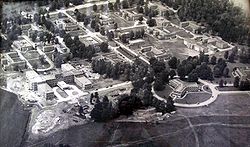Benton State Hospital
| Benton State Hospital | |
|---|---|
 Aerial shot of Benton State Hospital | |
| Construction Began | 1931 |
| Current Status | Active |
| Building Style | Cottage Plan |
| Alternate Names |
|
History[edit]
By 1928, Arkansas State Hospital was seriously overcrowded and in 1929 the legislature authorized creation of a new facility. Land for the new unit of the State Hospital was purchased on Highway 67 approximately five miles southwest of Benton. The first buildings were completed in 1931. In 1934, the State secured a WPA loan and the work was completed with 16 buildings ready for occupancy in 1935. The first patient was admitted to the Benton Unit on June 7., 1936. It soon became evident that the 16 dormitories were inadequate and so a 352 bed capacity building (Bldg 67) was completed on October 29, 1947. In April 1951, another new building with 400 ward beds and 60 infirmary beds (Bldg 70) was completed.
The 1957 Legislature authorized the State Hospital to cease all farming operations. The stock, timber, etc., were disposed of and the patients were transferred to Benton. In 1962, a joint rehabilitative project was initiated at the Benton Unit. Building 7 was remodeled to house the project which was designed to screen all State Hospital patients for Rehabilitative potential. The program was started in May 1962 with one building, 8 employees, and 30 chronic patients. In about 1965, Building 18 was completed and the administrative staff of the Rehabilitation Services moved into it.
The 1961 Legislature appropriated $6,000,000 for the construction of new buildings at the Little Rock State Hospital to replace the old buildings. Construction started in 1963. Until that time, all admissions of patients had been to the Little Rock Hospital where they were evaluated. Chronic and elderly patients were transferred to the Benton Unit. Since the new buildings would not have the bed capacity of the old buildings, it was decided to open an admission office at the Benton Unit. The admission office was opened July 1, 1963.
In 1976 a Legislative Committee recommended that the Psychiatric Service at Benton be closed and moved to the Little Rock State Hospital. In preparation for this move on August 30, 1976, all the patients on Building 62 were moved to Building 59. This move combined all the admissions from Southwest Arkansas to Building 59 and all the admissions from Southeast Arkansas to Building 58. This also permitted part of the Medical Staff to be moved to the Little Rock State Hospital to prepare for receiving the Benton Psychiatric facilities.
On September 30, 1977, the last patient on Building 61 was transferred to the Benton Services Center Nursing Home and Building 61 was closed. That officially closed the Psychiatric Service and the Benton Services Center Hospital. In 1981 a new nursing home building was completed.[1]
Images of Benton State Hospital[edit]
Main Image Gallery: Benton State Hospital
Cemetery[edit]
The Arkansas State Hospital Cemetery in Little Rock dates back to 1882 and has been moved several times. Graves were disinterred and moved to West Little Rock and subsequently disinterred from that location to the Haskell area. A plaque and statue honoring the former patients of ASH remains on the grounds of the new government buildings on Natural Resource Drive in West Little Rock. The current cemetery is comprised of 35 rows, with as many as 45 plots in each row. Based on the Arkansas State Hospital Cemetery Book and Site Survey compiled by Flossie McMurray in the early 1980s, there are well over 1000 individuals buried at Benton #1, some in individual graves and others in group graves ranging from 6 to as many as 30 or more. As of 2010, transport records which occasionally include identification of the deceased and the cemetery and/or institution from which their remains were shipped, exist for a handful of years. Based on the known populations at the Arkansas State Hospital, and myriad families seeking information about their family members who have been documented to have passed away in the institution, many bodies and records remain unaccounted for.

